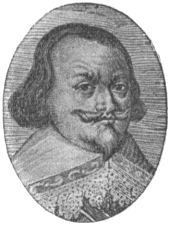Battle of Chemnitz (1639)
| date | April 4th jul. / April 14, 1639 greg. |
|---|---|
| place | Chemnitz |
| output | Victory of the Swedes |
| Parties to the conflict | |
|---|---|
| Commander | |
| Troop strength | |
| 8,000 men | 20,000 men |
| losses | |
|
approx. 100 officers and 1,500 mercenaries in captivity |
|
Wallerfangen - Dömitz - Haselünne - Wittstock - Rheinfelden siege - Rheinfelden battle - Breisach Siege - Witten Weiher - Vlotho - Ochsenfeld - Chemnitz - Bautzen siege - Freiberg sieges - Riebel Dorfer Mountain - Dorsten - Preßnitz - La Marfée - Wolfenbüttel siege - Kempen Heath - Swidnica - Breitenfeld - Klingenthal - Tuttlingen - Freiburg - Jüterbog - Jankau - Herbsthausen - Alerheim - Korneuburg - Totenhöhe - Hohentübingen - Triebl - Zusmarshausen - Wevelinghoven - Dachau - Prague siege
In the Battle of Chemnitz in the Thirty Years' War defeated on April 4th jul. / April 14, 1639 greg. a Swedish army formed from two corps under field marshals Johan Banér and Lennart Torstensson the united imperial and electoral Saxon army under Lieutenant General Matthias Gallas . After the victory, Banér was able to continue the siege of Freiberg that had begun in the spring of 1639 but was then canceled , but which ultimately remained unsuccessful.
prehistory
Already two days before the battle, Johan Banérs and Lennart Torstensson's army corps had joined forces near Zeitz, 60 km west of Chemnitz, and immediately set out on forced marches towards Chemnitz. The Swedish generals wanted to force the carefree imperial army camped there into a battle, because they had learned that an imperial army corps under Melchior von Hatzfeldt was coming from Eichsfeld to reinforce the still weak imperial army .
Course of the battle
The commanders of the Imperial Electoral Saxon army, who had their quarters west of Chemnitz near Hohenstein-Ernstthal between Chemnitz and Zwickau, only learned of the threatening unification of the two Swedish corps on the following day and decided to retreat to Chemnitz immediately. The imperial field marshal Matthias Gallas had already left the quarters with the army and only started the retreat covered by a rearguard of 300 men. In the process of withdrawal, the rearguard of the imperial army was surprised by the united Swedish army and, fighting violently, was driven back to the main body of the army. A swamp area defended by imperial dragoons prevented the Swedish troops from quickly following the fleeing troops and advancing to Chemnitz. The time gained gave the two commanders of the Imperial Saxon Army Raimondo Montecuccoli and Rudolph von Marzin the opportunity to set up the army in battle order . The left wing consisted of cuirassiers and was connected to the town of Chemnitz. The right wing stood behind the Chemnitz river of the same name .
After the first four Swedish cavalry regiments had overcome the marshland, under the leadership of the body regiment von Banér, they attacked the left wing of the imperial army very hastily and were driven back with heavy losses. Only after another attack with three additional cavalry regiments did the left wing of the Imperial Army, which was unfavorably and very cramped, break up completely and fled. Together with surviving fleeing mercenaries, the remaining Swedish cavalry regiments now attacking were able to cross the Chemnitz river. There they also drove the poorly positioned right wing of the Imperial Army, which had witnessed the collapse of the left wing, to flee as well. The infantry regiments also joined the escape and were destroyed by the regiment of the Swedish general Torsten Stålhandske .
Thus the battle ended with a heavy defeat for the imperial-Electoral Saxon imperial army. The Swedish army, which had not used its artillery and infantry at all, was able to capture the artillery pieces and the train of the opposing army. After the victory, the way to Bohemia was open for Johan Banér . At first, however, Banér besieged the mountain town of Freiberg again and just as unsuccessfully.
literature
- Heinrich Oraeus : Theatrum Europaeum . Vol. 4, 1692: pp. 91-96 .
- EO Schmidt: Germany's battlefields - 1620–1813 . Leipzig 1842.
- Friedrich Rudolf von Rothenburg, battles, sieges and skirmishes in Germany and neighboring countries , digitized version
